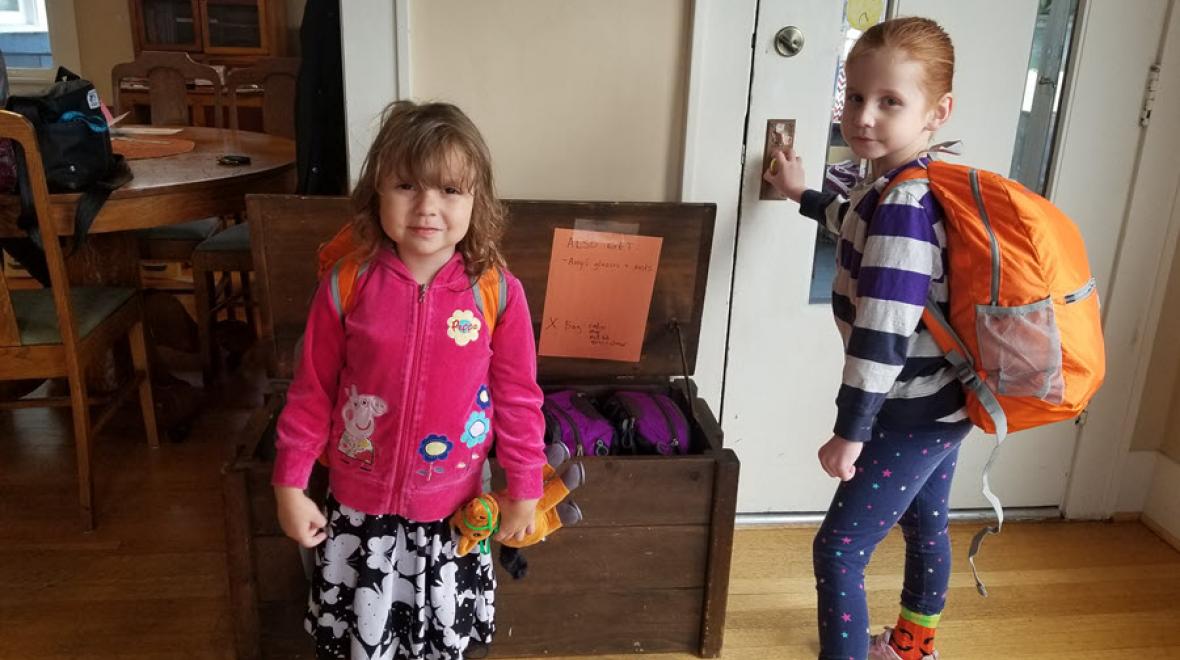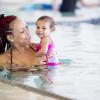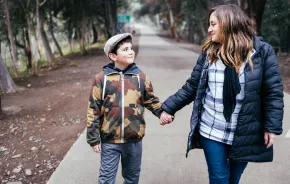
Photo:
Katalina and Benjamin Freeman pictured with their emergency “bug-out bag” backpacks, packed with evacuation essentials. Kids’ bags should also include: ID, contact information and small games or a comfort item, such as Katalina's stuffed toy. Bags should be stored right by the door for quick access in the event an evacuation is necessary. Photo credit: Brianna Enriquez, M.D.
Editor's note: This article was sponsored by Seattle Children's Hospital.
When the world at large starts to feel too scary, home is where we feel safe. But home isn’t actually as safe as it feels unless you make it that way. Fortunately, with a little planning and practice, it isn’t difficult to defend your home against accidents and prepare for even the worst emergencies. In fact, safety preparation can even be, dare we say, kind of fun?
Disaster preparedness
“Disaster is tricky to get people engaged in. It can feel so overwhelming,” says Dr. Brianna Enriquez, medical director for emergency management at Seattle Children’s Hospital. She says the best way to overcome the paralysis caused by being overwhelmed is to “Take it in pieces and make little steps. Just try to be more prepared tomorrow than you are today.”
Earthquakes are the most likely disaster to strike our region. But when it comes to getting ready, the steps to prepare for any natural disaster are the same.
- Make a plan: Figure out how your family members will connect with each other if disaster strikes while you are at work, at school or any of the places you regularly spend time.
- Make a kit: At a minimum, store a gallon of water per person (and pet) for three to seven days. Then put together a “bug-out bag” for each member of your family in case you need to evacuate. This includes water, a hand-cranked radio and a first aid kit. Kids’ bags should also include: ID, contact information and small games or comfort items. Don’t overpack: Reference Seattle Children’s suggested household packing list.
- Be informed: Download the Red Cross emergency and earthquake apps, sign up for regional emergency alerts and continue learning about preparedness.
The American Academy of Pediatrics provides a detailed family readiness guide with plan templates. And if you’re confused by conflicting accounts of what you should do during an earthquake, the Seattle Times recently published a regionally appropriate guide.
Fire safety
You already know you need smoke alarms, but does your child know what to do when one goes off? “Focus more on getting out of the house than trying to put out a fire,” says Enriquez. You don’t want kids looking for family members or trying to catch the cat — stress that that is the firefighters’ job. Make sure your kids know at least two ways out of the house from every room; agree on a meeting spot a safe distance from the house; and practice. The Red Cross provides detailed fire safety information.
Weathering winter storms
Severe storms that knock out power lines are not uncommon in our region. Usually, the power is back on in a few hours, but be prepared for it to take days.
“People need to prepare for hunkering down at home, or plan to have another place to go if the power goes out,” says Enriquez. In rural areas, it might be worth purchasing a generator and learning how to operate it safely. If you have a fireplace, keep enough wood on hand to last for several days, even if you don’t usually use it. If you don’t, make sure you have lots of blankets, but don’t try to use barbecues or other ignitable heat sources for warmth. They are not only a fire risk, but they can also cause carbon monoxide poisoning when used indoors.
Gun safety
Gun violence is now the third leading cause of death in children. Every day in America, eight children and teens are shot in instances involving an improperly stored or misused gun found in the home. “If you choose to have a gun in your home, have triple-safe storage,” says Enriquez. That means keeping the gun unloaded, in a locked cabinet, and with ammunition stored separately. Children’s Hospital offers workshops and lock giveaways.
“Accidents can happen at other houses,” says Enriquez. Whether you own a gun or not, talk to your kids about them so that they understand guns are not toys and should not be touched if they find one. It may feel awkward, but ask the loaded question before you agree to a play date at someone else’s house.
In Washington state, 78 percent of gun deaths (of all ages) are suicides; do not ignore the connection between gun safety and mental health.
Drowning prevention
Swimming pools aren’t very common in our area, but lakes are, and drowning deaths are a very real risk, especially in the summer. “Often at parties with lots of adults there is a diffusion of responsibility and no one is really watching,” says Enriquez. She warns that drownings occur silently — nothing like in the movies. Whenever your family is around water, name a watcher and tag-team. Enriquez says when her family vacationed at a place with a pool, the adults used a bracelet to signify who was on “pool-watching” duty.
Common household hazards
“Parents have gotten pretty good about seat belts and helmets and child-proofing,” says Enriquez. But visitors are not always as careful, and poisoning can occur when grandparents or houseguests leave their medication out in the open, or even in a purse.
A surprising number of young children fall out of second-story windows. “Make sure little kids can’t open the window by themselves, and that there is nothing to climb on, such as tables or other furniture, under the window,” says Enriquez. Climbing on furniture — whether it’s near a window or not — is a common cause of household accidents for young children. Securing TVs and bookcases to the wall will help keep kids from pulling furniture over on top of themselves, and makes your house safer in an earthquake, too.
Learn, practice and have fun
Get to know your neighbors, and plan together. “Having a plan with your neighbors makes your response much stronger,” says Enriquez. Knowing who has heat, who has medical experience, and who might need help makes everyone safer.
Preparedness doesn’t have to be scary. Ready.gov is a valuable preparedness resource for parents and for kids, who can play games to become a “Disaster Master” and Prepare With Pedro. “There is no question that drills are helpful. You can make it fun,” says Enriquez. Her kids enjoy their home drills, during which they figure out multiple exits for fires and practice drop, cover and hold drills for earthquakes in different rooms of their house.
“Parenting is about preparing kids to handle life,” says Enriquez. “This is a good life lesson: You can plan and prepare for challenges.”
Additional home safety resources: |
|
Sponsored by: |
 |











